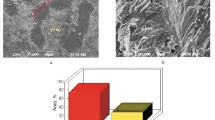Abstract
The influence of kinematic parameters of explosive welding of brass L63 with Invar 36N on the quality of the layers and the structure of the welding zone of thermobimetal grade TB 1353 (TB 130/17) was experimentally studied. It is shown that, since alloy L63 containing a fusible component (zinc) is used as an active layer in the thermobimetal, the choice of welding mode should be carried out taking into account the prevention of the “ejection” effect. In this case, the flow of shock-compressed gas with high pressure, moving in the gap at high speed, carries a low-melting phase; therefore, the strength of the connection is reduced up to full loss of strength, and also the phase (chemical) homogeneity of the layers in the welding zone is violated. Joints of the thermobimetals were tested with an ultrasonic flow detector. The structure of the welding zone was investigated by optical and electron microscopy on a metallographic section. The toughness of layers during breaking off was determined on ring samples. Tests on lateral bending and bending of the cladding layer inside were carried out. The optimum mode providing the explosive welding in the solid phase with 100% continuity of the adhesion layers and toughness of layers during breaking off at the level of the strength of brass and the high-grade structure of the weld zone was determined.



Similar content being viewed by others
REFERENCES
Bashnin, Yu.A., Perepelitsa, I.V., and Mosalov, A.N., Termobimetally: kompozitsii, obrabotka, svoistva (Thermal Bimetals: Composition, Processing, and Properties), Moscow: Mashinostroenie, 1986.
Korickii, Yu.V., Pasynkov, V.V., and Tareev, B.M., Spravochnik po elektrotekhnicheskim materialam (Handbook of Electrical Materials), Leningrad: Energoatomizdat, 1988, vol. 3.
Bondarenko, S.Yu., Rikhter, D.V., Pervukhina, O.L., and Pervukhin, L.B., Determination of parameters of shock-compressed gas in the welding gap ahead of the contact point during explosion cladding, Avtom. Svarka, 2009, no. 11, pp. 46–48.
Pervukhin, L.B., Pervukhina, O.L., and Bondarenko, S.Yu., Cleaning of welding surfaces from oxides and impurities and their activation during explosion welding, Avtom. Svarka, 2010, no. 7, pp. 46–49.
Pervukhina, O.L., Saikov, I.V., Pervukhin, L.B., and Khaidarov, F.B., Deformation and thermodynamic processes in explosion cladding of cylindrical components with titanium, Weld. Int., 2012, vol. 26, no. 4, pp. 318–321.
Deribas, A.A., Fizika uprochneniya i svarki vzryvom (Physics of Hardening and Explosion Welding), Novosibirsk: Nauka, 1980.
Zel’dovich, Ya.B. and Raizer, Yu.P., Fizika udarnykh voln i vysokotemperaturnykh gidrodinamicheskikh yavlenii (Physics of Shock Waves and High-Temperature Hydrodynamic Phenomena), Moscow: Nauka, 1966.
Gulyaev, A.P., Metallovedenie. Uchebnik dlya vuzov (Metal Science: Manual for higher Education Institutions), Moscow: Mashinostroenie, 1986.
Bataev, I.A., Lazurenko, D.V., Tanaka, S., Hokamoto, K., Bataev, A.A., Guo, Y., and Jorge, A.M., High cooling rates and metastable phases at the interfaces of explosively welded materials, Acta Mater., 2017, vol. 135, pp. 277–289.
Lysak, V.I. and Kuz’min, S.V., Svarka vzryvom (Explosive Welding), Moscow: Mashinostroenie, 2005.
Khaustov, S.V., Kuz’min, S.V., Lysak, V.I., and Pai, V.V., Thermal processes in explosive welding, Combust., Explos. Shock Waves (Engl. Transl.), 2014, vol. 50, no. 6, pp. 732–738.
Pai, V.V., Gulevich, M.A., Yakovlev, I.V., Lysak, V.I., Kuz’min, S.V., and Khaustov, S.V., Temperature measurement at the interface of metal compounds in explosive welding, Izv. Volgograd. Gos. Tekh. Univ., 2012, no. 14, pp. 21–26.
Pervukhina, O.L. and Denisov, I.V., The specifics of producing steel to brass bimetal using explosion welding, Adv. Mater. Technol., 2017, no. 3, pp. 44–46.
Pervukhin, L.B. and Pervukhina, O.L., Interaction of impact-compressed gas in the welding gap with the welded surfaces in explosive welding, Weld. Int., 2017, vol. 31, no. 6, pp. 457–461.
Author information
Authors and Affiliations
Corresponding authors
Additional information
Translated by V. Selikhanovich
Rights and permissions
About this article
Cite this article
Saikov, I.V., Malakhov, A.Y., Saikova, G.R. et al. Influence of Explosive Welding Parameters on the Structure of Interface in Brass–Invar Thermobimetal. Inorg. Mater. Appl. Res. 11, 448–452 (2020). https://doi.org/10.1134/S2075113320020331
Received:
Revised:
Accepted:
Published:
Issue Date:
DOI: https://doi.org/10.1134/S2075113320020331




